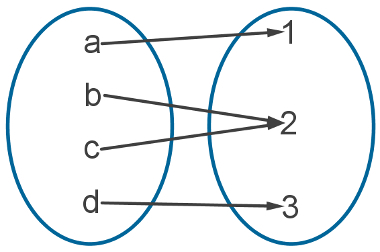What is thermal convection?
Convectionthermal, or simply convection, it is a process of heat transmission. When one fluid, like air or water, is heated, your portions morehot can suffer thermal expansion, expanding your volume. In other words, this heated fluid starts to occupy a volumebigger than the fluid in the surroundings.
whole body inserted in a liquid or gaseous medium is subjected to the action of a force vertical for up, call of buoyancy. this force is proportional to the volume of the fluid displaced by the body. As the heated liquid occupies a larger volume, it suffers more thrust and rises, giving rise to a movementascendant. The rise of the heated fluid gives room for the cooler portions and moredense of fluidcome down, forming a movementdownward. The process continues until all the fluid is at the same temperature.
Convection heat transmission
When we light a fireplace or fire, heat is transmitted around the region where the wood is burned. This transmission occurs from phenomena such as
convection and the irradiation. Thus, it is possible to feel the hot air rising, taking with it soot and other gases produced during the burning. Furthermore, even though we are not so close to the fires, we can perceive the heat due to the large emission of raysinfrared.When cooking food, the liquid undergoes a convection process until its entire volume is in thermal equilibrium, ceasing the convective currents. At the beginning of cooking, the water that is in contact with the bottom of the pan receives heat by conduction. The increase in temperature leads to a decrease in density, so this slightly warmer water rises, transferring heat to its surroundings through its upward movement. The process is repeated until all the fluid reaches its temperatureinboiling.
Convection, irradiation and conduction
Convection is one of the heat transfer processes. In addition to it, there is conduction and irradiation. Check the definition of each of these processes:
Driving: it is the transfer of heat through contact between the surfaces of two or more bodies that are at different temperatures.
Convection: it is the heat transfer that occurs in fluids that have temperature differences in their content. When heat is supplied to a fluid, convective currents form, which transmit the heat until all the fluid comes into thermal equilibrium.
-
Irradiation: it is heat transfer carried out by means of electromagnetic waves. Every body that is at temperatures other than absolute zero exchanges heat in the form of electromagnetic waves constantly with its surroundings. The Sun, for example, warms the Earth by emitting infrared and visible light, among other electromagnetic waves.
Do not stop now... There's more after the advertising ;)
convection examples
Now that we know what convection is, how about giving some examples of situations in which this process is present?
→ Convective oven
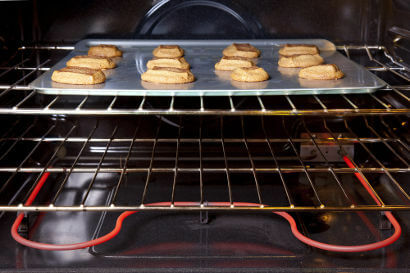
Conventional ovens, electric Or the gas, have their flame or heater located in the morelow from the oven. In this way, the heated air rises, while the cooler air descends, forming convection currents until the entire oven is at the same temperature.
→ Convective cloud
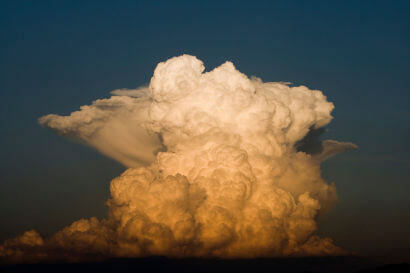
Convective clouds are known to be very long, extending from 11 km until 23 km tall. Its elongated shape arises from the hot air currents that rise inside. At the top of these clouds, the rising air gains a horizontal direction, giving this category a flattened appearance, like an anvil.
The most famous convective clouds are the cumulonimbus, responsible for major storms, hailstorms and snow and even hurricanes. Learn more about cloud types by clicking on here.
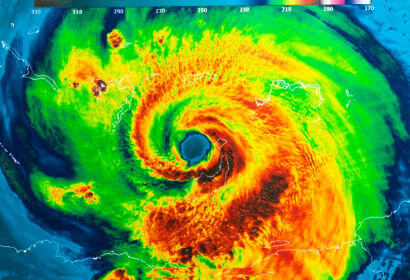
In the figure above, we have the distributionintemperatures in a hurricane. You tonesblue correspond to the regions more cold, while the tonesorange and reddish are the most hot.
Among other factors, we can say that hurricanes are formed as a result of a greatdifferenceintemperature between the ground and the atmosphere, creating strong ascending and descending convective currents. These currents are called high and low pressure zones respectively.
→ Air conditioning and heater
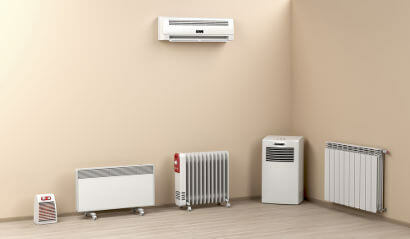
Air conditioners are usually installed in placestall, since the cold air they produce is moredense than ambient air. With that, the cold aircome down, it's the hot air rises, until the whole room is in thermal balance.
The heaters, in turn, are placed on the floor or in low places so that the hot air emitted by them can rise, heating the entire environment.
Convection Summary
Convection is one of the forms of heat transfer and occurs as a result of the upward and downward movement of portions of a fluid at different temperatures.
When a fluid is heated, its hotter portion decreases in density and suffers more from buoyancy. Thus, upward convective currents are formed.
By Me. Rafael Helerbrock

